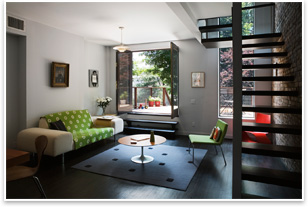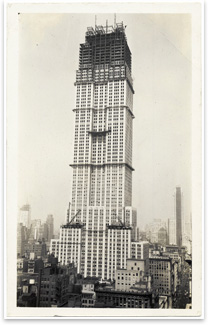| Design
Culture Adapts to Shrinking Budgets
by Gideon Fink Shapiro
 Summary: When
construction budgets are cut, does architecture suffer? The recession
has given new impetus to this perennial question of ends and means.
Conventionally speaking, more generous budgets allow more generous
architecture, and vice versa. But beyond the common concessions to
value-engineering, how is the economic crisis affecting design practice? Summary: When
construction budgets are cut, does architecture suffer? The recession
has given new impetus to this perennial question of ends and means.
Conventionally speaking, more generous budgets allow more generous
architecture, and vice versa. But beyond the common concessions to
value-engineering, how is the economic crisis affecting design practice?
For one answer, just ask the designer responsible for the exterior
of the planned 76-story Beekman Tower in New York City—Frank
O. Gehry, FAIA. The developer, Forest City Ratner, has halted construction
around 40 stories, pending labor negotiations, and has substituted
a flat curtain wall for Gehry's undulating design on one of the building's
seven faces.
A contrary school of thought sees the slackening market as an opportunity
for architects to rediscover the core values of their profession. "What
designers do really well is work within constraints, work with what
they have," MoMA architecture and design curator Paola Antonelli
told the New York Times in January. She predicted that the recession
will bring "less design, but much better design.” If this
notion sounds idealistic, it also echoes the sentiments of some practicing
architects. "I think it's an exciting period we're in now," says
Mark DuBois, AIA, a partner at Ohlhausen DuBois Architects in New
York, "It's really about getting back to basics, focusing on
what works and what makes sense." DuBois believes the former
period of untrammeled showmanship may be giving way to a new ethos
of "responsible innovation."
 While architects relied on the ingenuity of engineers and builders
to realize experimental designs during the boom years, design-build
collaboration is now more important than ever. The constructability
of a design can mean the difference between having it built as planned
and losing control of the project. According to Michael Tower, AIA,
co-founder of the Brooklyn-based Studio Tractor, "A bid number
is going to come in more reasonably if we're very specific about
how to build it." In this way, Tower and his partner, Mark Kolodziejczak,
AIA, embrace value-engineering within the design process, believing
that it contributes to the harmony of form, function, and materials. While architects relied on the ingenuity of engineers and builders
to realize experimental designs during the boom years, design-build
collaboration is now more important than ever. The constructability
of a design can mean the difference between having it built as planned
and losing control of the project. According to Michael Tower, AIA,
co-founder of the Brooklyn-based Studio Tractor, "A bid number
is going to come in more reasonably if we're very specific about
how to build it." In this way, Tower and his partner, Mark Kolodziejczak,
AIA, embrace value-engineering within the design process, believing
that it contributes to the harmony of form, function, and materials.
Studio Tractor communicates closely with contractors to find ways
in which less specialized workers can complete more of their highly
refined detailing. If a carpenter can do some of the work normally
reserved for a metalworker, for example, the cost of construction
decreases. The epitome of architect-contractor synergy may be the
Empire State Building, completed in 1931 as the Great Depression
continued to worsen. "So brilliantly conceived and executed
was the building campaign that the Empire State was completed ahead
of schedule and under budget," wrote the historian Carol Willis
in a 1998 exhibition at the Skyscraper Museum.
The “post-luxury” approaches
to design
Retrofitting existing
buildings has emerged in recent years as an eco-effective alternative
to new construction. In the context of the recession, it also makes
fiscal sense. The firm BNIM was recently commissioned to renovate
200,000 square feet of office space in One Kansas City Place, a 1980s
skyscraper. Although the client, Kansas City Power and Light,
commissioned grand new buildings in previous eras of expansion, this
time the company favored the less costly strategy of renovation.
BNIM is also helping clients in Kansas City to redevelop vacant lots,
engaging in a kind of "retrofitting" at
the urban scale.
Calling on design intelligence to transcend economic constraints,
New Orleans-based Billes Architecture has launched a student design
competition seeking new 1,000-1,500-sq.-ft. homes that cost less
than $150,000. Ten finalists will be flown to New Orleans April 11,
where a jury of architects and editors will select several to receive
cash prizes and the potential to develop their concepts into buildings.
As with the earlier Make It Right New Orleans housing program organized
by a nonprofit association including Graft architecture and the actor
Brad Pitt, the Billes competition aims to beat tight budgets with
creative wit.
 Regardless of shrinking budgets, architects are continuing to educate
their clients about the value of good design. In pitching a concept
for a new volunteer-firehouse and community center, Ohlhausen DuBois
is working to persuade the client that the cost of a glass wall is
more than offset by the benefits it will bring to its users, from
simply feeling good to lowering energy bills. Studio Tractor hopes
to show a current residential client that a beautiful slab of natural
stone is a better investment than a high-end kitchen stove. Regardless of shrinking budgets, architects are continuing to educate
their clients about the value of good design. In pitching a concept
for a new volunteer-firehouse and community center, Ohlhausen DuBois
is working to persuade the client that the cost of a glass wall is
more than offset by the benefits it will bring to its users, from
simply feeling good to lowering energy bills. Studio Tractor hopes
to show a current residential client that a beautiful slab of natural
stone is a better investment than a high-end kitchen stove.
"We're looking at this period as post-luxury rather than a
return to the cheap days," says Kolodziejczak. The difference
between the two is open to interpretation. But as extravagance gives
way to utility, the design process will increasingly focus on making
sophisticated use of inexpensive materials and efficient building
techniques. The challenge, in other words, is to find the poetic
within the prosaic. |


 Summary:
Summary: While architects relied on the ingenuity of engineers and builders
to realize experimental designs during the boom years, design-build
collaboration is now more important than ever. The constructability
of a design can mean the difference between having it built as planned
and losing control of the project. According to Michael Tower, AIA,
co-founder of the Brooklyn-based Studio Tractor, "A bid number
is going to come in more reasonably if we're very specific about
how to build it." In this way, Tower and his partner, Mark Kolodziejczak,
AIA, embrace value-engineering within the design process, believing
that it contributes to the harmony of form, function, and materials.
While architects relied on the ingenuity of engineers and builders
to realize experimental designs during the boom years, design-build
collaboration is now more important than ever. The constructability
of a design can mean the difference between having it built as planned
and losing control of the project. According to Michael Tower, AIA,
co-founder of the Brooklyn-based Studio Tractor, "A bid number
is going to come in more reasonably if we're very specific about
how to build it." In this way, Tower and his partner, Mark Kolodziejczak,
AIA, embrace value-engineering within the design process, believing
that it contributes to the harmony of form, function, and materials. Regardless of shrinking budgets, architects are continuing to educate
their clients about the value of good design. In pitching a concept
for a new volunteer-firehouse and community center, Ohlhausen DuBois
is working to persuade the client that the cost of a glass wall is
more than offset by the benefits it will bring to its users, from
simply feeling good to lowering energy bills. Studio Tractor hopes
to show a current residential client that a beautiful slab of natural
stone is a better investment than a high-end kitchen stove.
Regardless of shrinking budgets, architects are continuing to educate
their clients about the value of good design. In pitching a concept
for a new volunteer-firehouse and community center, Ohlhausen DuBois
is working to persuade the client that the cost of a glass wall is
more than offset by the benefits it will bring to its users, from
simply feeling good to lowering energy bills. Studio Tractor hopes
to show a current residential client that a beautiful slab of natural
stone is a better investment than a high-end kitchen stove.